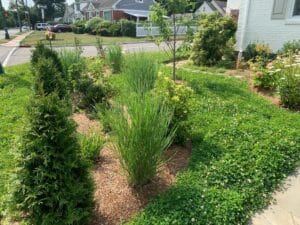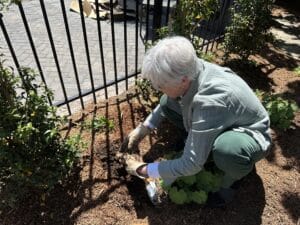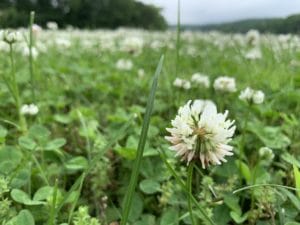Hello, fellow lovers of all things green. Recently, I designed a low-maintenance garden filled with perennials, shrubs, and trees for year-round interest in Bergen County, NJ, not far from New York City. Around it, we planted a pollinator-friendly lawn alternative: a combination of No-Mow clover mixes from American Meadows. Both fill the role of a traditional manicured lawn without all the work, saving you time and money. The flowering mix includes delightful English Daisies, sure to bring a smile.
“My lawn that I love is under assault.”

English Daisies mixed with clover is sure to bring a smile.

Linda and Jim moved from California to be near their children and grandkids. While they were overseas, I received an email: “My lawn that I love is under assault. I love the look, but the city just cited me. I have to mow it now— so sad. The backyard looks just great. I hope I don’t have to mow that.”
He sent me the specifics of the town’s code: ‘All premises and exterior property shall be managed free from weeds or plant growth in excess of 10 inches.’
It’s hard to imagine their clover lawn growing over 10 inches. I sent Jim a few links, including the history of lawns in Europe, where clover lawns were the norm. In the United States, clover was part of lawn seed mixes before the 1950s, when chemical companies began marketing broadleaf weed killers that also killed clover. And so, clover became considered a weed. Yet, clover offers many benefits and is gaining popularity again.
Clover Lawns were desired before the 1950s

A field of dreams rather than a yard of chemicals.

Jim is enjoying his new garden.

Linda is digging in Dahlia bulbs.
A few years ago, I stumbled upon the most beautiful field of clover, leading to glorious reasons why white clover makes a magnificent lawn alternative. Pollinators were scurrying from one dainty puff to another, busily gathering nectar and pollen. Their hairy legs were combing through each petal of the pinkish-white blooms. There were primarily honeybees, but many bumblebees, too. All were sharing the bounty politely– no arguments over whose was whose. I stood quietly, listening to their soft buzz, and saw a rhythm in their movements.
The Benefits of White Clover in Lawns
It’s interesting how a honey bee can land on a clover flower, assess fruits, and then quickly move on. Perhaps the pollen was already taken. I tiptoed through the field, grabbing photos and carefully not stepping on anyone. Beyond the beauty of the expansive flowers lighting up the field as dusk fell, the ground serves as a field for children. It’s comforting to know weed killers and other chemicals are likely not being used there, especially in the wake of the glyphosate controversy in Roundup and others.

Trifolium repens, also called Dutch clover or white clover.
You can also mix clover with grass seed in high-traffic areas like sports fields, where it’s becoming a new trend for many reasons. Clover is drought tolerant, so your lawn will stay greener and require little or no mowing.
White clover (Trifolium repens) only grows three to six inches tall. Most mow once a season after the flowers fade to encourage a second bloom. You can mow it more often if you’re fussy about having a perfectly groomed-looking lawn. Mixed with traditional Bluegrass or Bermuda grass you’ll need to cut more often.
A Field of Dreams rather than a yard of chemicals
Clover does not require fertilization, as it’s a nitrogen fixer that farmers frequently use as a living mulch between rows of vegetables. It feels comfy to walk on even barefoot, though it’s probably best not to when they’re in bloom unless you tiptoe around to avoid stings.
It can grow in the lousiest soil without discoloration from your canine kid’s patches. Plus, clover seeds are inexpensive. You’ll never need herbicides like Roundup or other ugly stuff, as white clover squelches weeds. Most magnificent is clover attracts bountiful insects, like our essential pollinators, that have been dangerously in decline—a Field of Dreams rather than a yard of chemicals.
Garden Dilemmas? AskMaryStone@gmail.com and your favorite Podcast App.
There’s more to the story in the Garden Dilemmas Podcast:
Link to American Meadows
I invite you to read the Alternatives to Harmeful Weed Killers, which includes more environmentally thoughtful ways to remedy weeds.



Hello Mary,
refreshing to know there’s like minded environmentally concerneds out there and ‘growing’ [no pun intended] i live in zone 8-9ish, just north of seattle along the sound and want to plant a lawn alternative like clover grass that the growing rabbit population won’t gorge themselves on. Any ideas?
Hi Patricia, I agree that more of us are being kind to our dear Earth. If your lawn alternative plans are for areas only occasionally traveled, Carex could be a good choice. I dug in and found that “Carex tumulicola, commonly known as Foothill Sedge or Berkeley Sedge, is a versatile and adaptable evergreen perennial grass-like plant native to open woods, meadows, and coastal prairies from California to Washington. It is celebrated for its low-maintenance requirements, ornamental appeal, and ecological benefits.” per https://www.missouribotanicalgarden.org/. It grows a foot or two, which may be taller than you’d like, but pretty to view.
“Minimal pruning is generally needed. Trim back older, tattered leaves in late winter or early spring to encourage fresh growth. Can be cut back to 2-3 inches from the base for rejuvenation. Best propagated by division in spring or autumn.”
Another thought for an option that can handle foot traffic — plant Creeping Thyme amongst clover. I’ll bet the lovely herb odor will deter rabbits. And it will smell heavenly while walking through. Thanks for reading my post. Let me know how you make out, Mary Stone
thanks Mary, and for pursuing me through email. i like the idea of the thyme scent in w/the clover.
be well,
Patricia
You’re very welcome Patricia, Let me know how you make out! Enjoy the fragrance as you walk :^), Mary